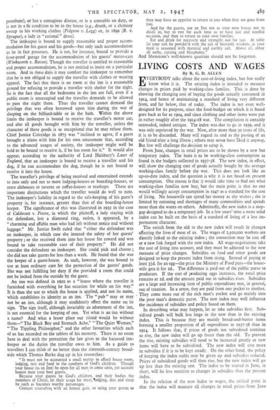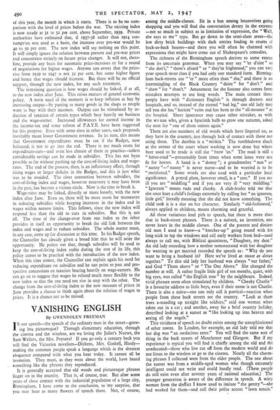LIVING COSTS AND WAGES
By R. G. D. ALLEN
EVERYBODY talks about the cost-of-living index, but few really know what it is. The existing index is intended to measure changes in prices paid by working-class families. This is done by showing the changing cost of buying the goods actually consumed in 1914, and hence of maintaining a standard of living very different from, and far below, that of today. The index is not even well- designed for its purpose, since the food-budget on which it is based goes back as far as 1904, and since clothing and other items were put in rather roughly after the 1914-18 war. The compilation is certainly outmoded, indeed antique. The index was due to go in 1939, and it was only reprieved by the war. Now, after more than 3o years of life, it is to be discarded. Many will regard its end as the passing of an old friend after a long illness ; others may never have liked it anyway. But few will challenge the decision to scrap it.
From June, changes in retail prices are to be shown by a new but temporary index. The basis is to be working-class consumption as found in the budgets collected in 1937-38. The new index, in effect, will show the changing cost of goods actually bought by the average working-class family before the war. This does not look like an up-to-date index, and the question is why it is not based on present consumption. One reason is that it would take time to find out what working-class families now buy, but the main point is that no one would willingly accept consumption in 1947 as a standard for the cost of living. No housewife can spend her money as she wishes ; she is limited by rationing and shortages of many commodities and spends more than she wants on others. Admittedly, the new index is a stop- gap designed to do a temporary job. In a few years' time a more solid index can be built on the basis of a standard of living of a less im- permanent character.
The switch from the old to the new index will result in changes affecting the lives of most of us. The wages of 2,500,000 workers are directly linked to the existing index ; the connection may be cast off or a new link forged with the new index. All wage-negotiations take the cost of living into account, and they must be adjusted to the new measure of price changes. Subsidies on food and other goods are designed to keep the present index from rising. Instead of paying at least 33.-d. for an egg—the price the Ministry of Food pays—the house- wife gets it for 2d.. The difference is paid out of the public purse to producers. If the cost of producing eggs increases, the retail price remains at 2d. and the amount paid out in subsidies rises. Subsidies are a large and increasing item of public expenditure met, in general, out of taxation. In a sense, they are paid from one pocket to another. They come more out of the rich man's pocket and go mainly into the poor man's domestic purse. The new index may well influence the incidence of subsidies and policy based on them.
In describing what may happen, let us take subsidies first. Sub- sidised goods will bulk less large in the new than in the existing index. This is because they are mainly bread-and-butter items forming a smaller proportion of all expenditure in 1937-38 than in 1914. It follows that, if prices of goods not subsidised continue to rise, the new index will go up faster than the old. To prevent the rise, existing subsidies will need to be increased greatly or new items will have to be subsidised. The new index will cost more in subsidies if it is to be kept steady. On the other hand, the policy of keeping the index stable may be given up and subsidies reduced. Prices of subsidised goods will then rise, but the new index will go up less than the existing one. The index to be started in June, in short, will be less sensitive to changes in subsidies than the present index.
In the relation of the new index to wages, the critical point is that the index will measure all changes in retail prices from June of this year, the month in which it starts. There is to be no com- parison with the level of prices before the war. The existing index is now steady at 31 to 32 per cent, above September, 1939. Private authorities have estimated that, if 1937-38 rather than 1914 con- sumpt;on was used as a basis, the increase over pre-war would be 4o to 5o per cent. The new index will say nothing on this point. It will simply ignore the relation between present and pre-war prices and concentrate entirely on future price changes. It will not, there- fore, provide any basis for automatic price-increases or for a round of negotiations for higher wages. Anyone can assert that the price- rise from 1939 to 1947 is not 32 per cent. but some higher figure and hence that wages should increase. But there will be no official support, through the new index, for any such statement.
The remaining question is how wages should be linked, if at all, ro the new index after June. This raises matters of general economic policy. A main need of the moment is to keep inflation at bay by increasing output—by putting as many goods in the shops as people want to buy with their incomes. Output can be stimulated by re- duction of taxation of certain types which bear heavily on business and the wage-earner. Increased allowances for earned income in the income-tax and some reform of P.A.Y.E. have been suggested for this purpose. Even with some rises in other taxes, such proposals inevitably mean lower Government revenue. In its turn, this means that Government expenditures must be cut if the Budget, now balanced, is not to go into the red. There is not much room for expenditure-cuts—and even less chance of them in practice—unless considerable savings can be made in subsidies. This has not been possible so far without pushing up the cost-of-living index and wage- rates. The end of the process, then, is an inflationary effect, through rising wages or larger deficits in the Budget, and this is just what was to be avoided. The close connection between subsidies, the cost-of-living index and wages, however necessary it may have been in the past, has become a vicious circle. Now is the time to break it.
Wage-rates may be linked, directly or more loosely, with the new index after June. Even so, there will be more room for manoeuvre in reducing subsidies while keeping increases in the index and in wages within narrow limits. This follows, since the new index will respond less than the old to cuts in subsidies. But this is not all. The time of the change-over from one index to the other provides in itself an opportunity to break the old link between the index and wages and to reduce subsidies. The whole matter must, in any case, come up for discussion at this time. In his Budget speech, the Chancellor has already given a broad hint that he will seize the opportunity. He points out that, though subsidies will be used to keep the cost-of-living index stable during the rest of its life, this policy ceases to be practical with the introduction of the new index. When this time comes, the Chancellor can explain again his need for reducing expenditure on subsidies and he can point to past and pro- spective concessions on taxation bearing heavily on wage-earners. He can go on to suggest that wages be related much more flexibly to the new index so that the one need not rise in step with the other. The change from the cost-of-living index to the new measure of prices in June provides a chance to think again about the relation of wages to prices. It is a chance not to be missed.



































 Previous page
Previous page